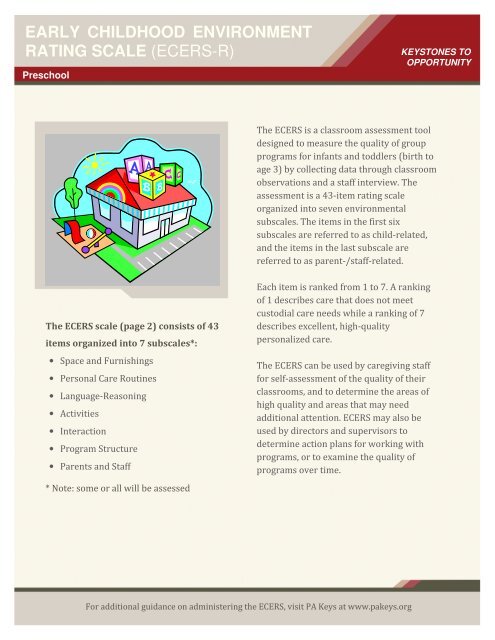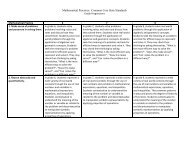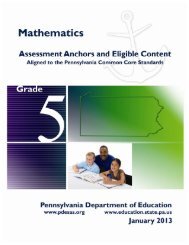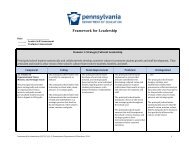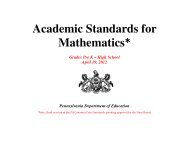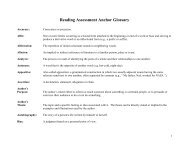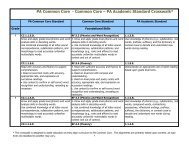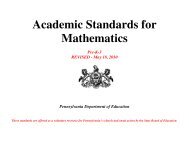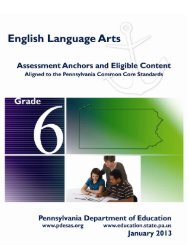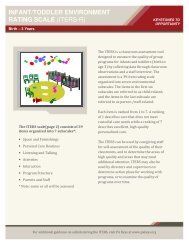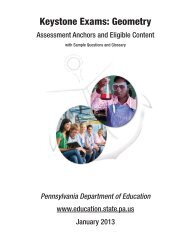early childhood environment rating scale (ecers-r) - SAS
early childhood environment rating scale (ecers-r) - SAS
early childhood environment rating scale (ecers-r) - SAS
- No tags were found...
You also want an ePaper? Increase the reach of your titles
YUMPU automatically turns print PDFs into web optimized ePapers that Google loves.
EARLY CHILDHOOD ENVIRONMENTRATING SCALE (ECERS-R)PreschoolKEYSTONES TOOPPORTUNITYThe ECERS is a classroom assessment tooldesigned to measure the quality of groupprograms for infants and toddlers (birth toage 3) by collecting data through classroomobservations and a staff interview. Theassessment is a 43-item <strong>rating</strong> <strong>scale</strong>organized into seven <strong>environment</strong>alsub<strong>scale</strong>s. The items in the first sixsub<strong>scale</strong>s are referred to as child-related,and the items in the last sub<strong>scale</strong> arereferred to as parent-/staff-related.The ECERS <strong>scale</strong> (page 2) consists of 43items organized into 7 sub<strong>scale</strong>s*:• Space and Furnishings• Personal Care Routines• Language-Reasoning• Activities• Interaction• Program Structure• Parents and Staff* Note: some or all will be assessedEach item is ranked from 1 to 7. A rankingof 1 describes care that does not meetcustodial care needs while a ranking of 7describes excellent, high-qualitypersonalized care.The ECERS can be used by caregiving stafffor self-assessment of the quality of theirclassrooms, and to determine the areas ofhigh quality and areas that may needadditional attention. ECERS may also beused by directors and supervisors todetermine action plans for working withprograms, or to examine the quality ofprograms over time.For additional guidance on administering the ECERS, visit PA Keys at www.pakeys.org
EARLY CHILDHOOD ENVIRONMENTRATING SCALE (ECERS)PreschoolKEYSTONES TOOPPORTUNITYActivities19. Fine motor20. Art21. Music/movement22. Blocks23. Sand/water24. Dramatic play25. Nature/science26. Math/number27. Use of TV, video, and/or computers28. Promoting acceptance of diversitySpace and Furnishings1. Indoor space2. Furniture for routine care, play and learning3. Furnishings for relaxation and comfort4. Room arrangement for play5. Space for privacy6. Child-related display7. Space for gross motor play8. Gross motor equipmentPersonal Care Routines9. Greeting/departing10. Meals/snacks11. Nap/rest12. Toileting/diapering13. Health practices14. Safety practicesLanguage-Reasoning15. Books and pictures16. Encouraging children to communicate17. Using language to develop reasoning skills18. Informal use of languageInteraction29. Supervision of gross motor activities30. General supervision of children (otherthan gross motor)31. Discipline32. Staff-child interactions33. Interactions among childrenProgram Structure34. Schedule35. Free play36. Group time37. Provisions for children with disabilitiesParents and Staff38. Provisions for parents39. Provisions for personal needs of staff40. Provisions for professional needs ofstaff41. Staff interaction and cooperation42. Supervision and evaluation of staff43. Opportunities for professional growthFor additional guidance on administering the ECERS, visit PA Keys at www.pakeys.org


